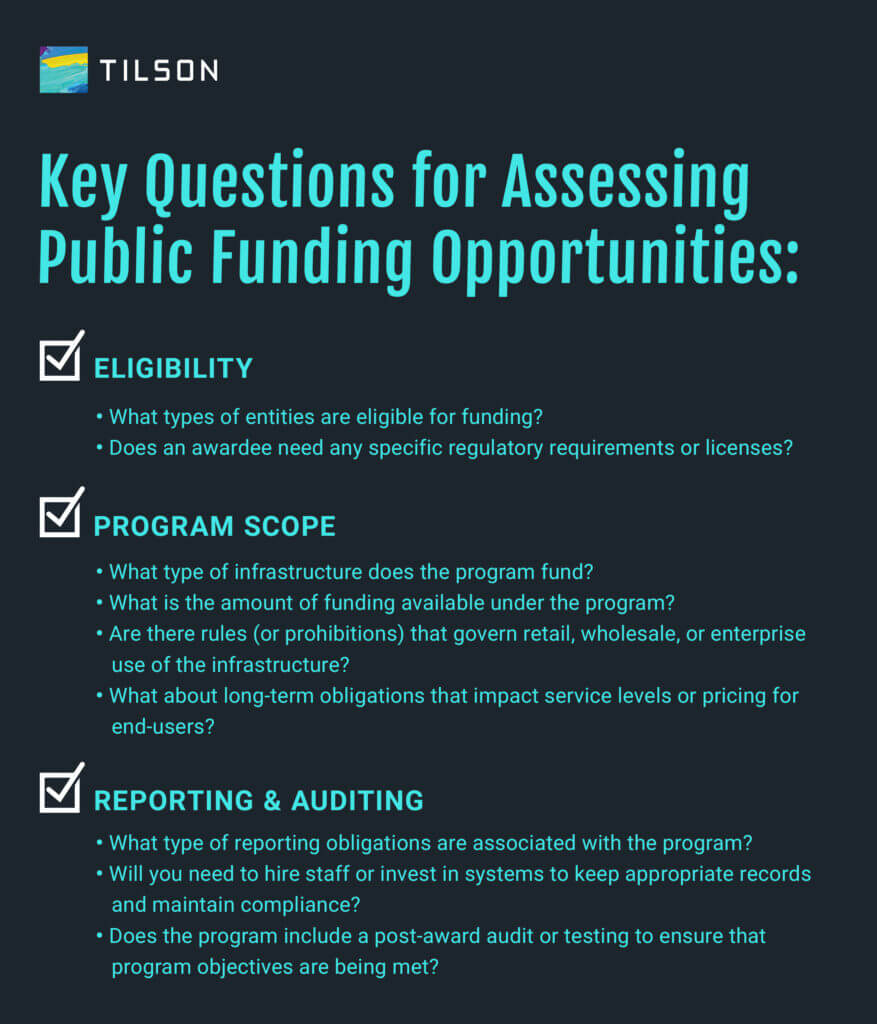Tilson provides comprehensive broadband deployment services to plan, design, build, and maintain the broadband networks that are essential to health, safety, and quality of life for communities.
//
When the federal government and states announce public funding opportunities for broadband infrastructure projects, there is no shortage of interest. From rural broadband deployments to programs seeking to address gaps in broadband access or affordability, a combination of municipal governments, new market entrants, and incumbent broadband providers regularly pursue funding opportunities.
The funding available under these programs is typically competitive, pitting the proposals of multiple applicants against each other for access to funding. There are three important pre-application steps you should consider before applying for public broadband infrastructure funding, to make sure you spend your time wisely and tackle programs that are the best for you and your intended project:

First, it is important for potential applicants to understand the rules governing eligibility. These criteria can vary by program and may be as simple as restrictions on the type of organization that can apply for funding – for example, requiring that an applicant be a municipal government, federally recognized tribal entity, not-for-profit organization, or for-profit company. In other cases, specific regulatory requirements may attach – for example, some Federal Communications Commission (FCC) programs require a provider be designated as an Eligible Telecommunications Carrier (ETC), while state programs may require that you be a Competitive Local Exchange Carrier (CLEC) under your respective state definition. Understanding these requirements is a crucial step in determining whether you can apply for funding on your own or develop a teaming arrangement with partners that bring specific capabilities and qualifications to a program.
Once you understand your eligibility, the next important consideration is the specific requirements of the program itself. In this step, we review the rules that govern qualified broadband technologies – including the allowability and preferential treatment of different technologies and speed tiers. You must also evaluate the beneficiaries of the infrastructure that is being funded; different programs seek to connect businesses, enterprises, and residential users, or weight the scoring system based on how many (or what speeds) the funded network may deliver to each type of user. This information on both technology and beneficiary is critical to designing a network that makes the best use of funds and scores well during the application process!
The final pre-application evaluation step is to fully understand the reporting and audit requirements. This includes any reports that you must file during the award period, as well as any verification, performance testing or compliance audit rights the funding organization may have during or after the award. Grant awardees regularly underestimate the burdens associated with quarterly or annual reporting obligations that are part of the government efforts to combat waste, fraud, and abuse in subsidy programs. Most grant programs contain some financial audit requirements, which may be a new impact to some organizations. The onus truly starts after awards have been made, with some programs, such as the FCC subsidy auctions, requiring 10 years of ongoing compliance and reporting. The repercussions for non-compliance can be heavy, ranging from minor withholding to full award claw-back and even penalties in excess of the award in some cases.
Importantly, verification / validation testing is becoming more common in infrastructure programs. This gives the funding entity the right to test network capabilities and speeds to ensure that the network constructed with public funds can deliver the capabilities promised in the funding application.
By following these steps when a funding program is announced, we believe you will be able to successfully evaluate a funding opportunity and determine whether it is a fit for your organization and capabilities. In our next article, we will present a roadmap for project evaluation and high-level design to help you define a project that fits within the specific requirements of a public subsidy.
Tilson’s broadband consulting team can lead you through the full broadband implementation lifecycle and provide best-in-class consulting from start to finish, tailored to meet and exceed your project goals and maximize the value your community derives from its network investment. We also offer turn-key network deployment, from design and engineering to make-ready and deployment.
Learn more: https://tilsontech.com/state-broadband-consulting or contact us to discuss your specific broadband deployment needs.

Adam Quinlan serves as Manager of Broadband Consulting at Tilson, leading a team of experienced consultants to plan, design, build, and maintain viable and cost-effective broadband solutions. Adam joined Tilson in 2016, with a strong technical background and leadership experience as a managing partner of a small law firm focused on the intersection of law and technology. He holds a Bachelor’s degree in Economics, a Juris Doctor from the University of Maine School of Law, and is a licensed member of the Maine and Massachusetts Bar.